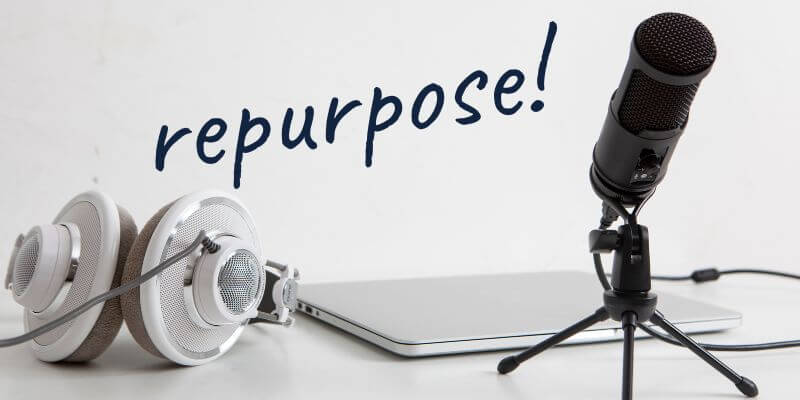Navigation Virtual Solutions, LLC


Repurposing Audio: A 4-Step Strategy to Explode the Reach of Existing Content
Consider this: Your company invested both time and money into producing each asset. Would you turn down the opportunity to get double or triple (or more!) the mileage out of each piece of content you already invested in?
Businesses with years—or decades—of industry experience likely possess a library of webinars, podcast episodes, training call recordings, YouTube videos, Instagram Lives, etc. If your content team were to take a quick inventory, would they find your shared drive and cloud storage brimming with these files?
You’re probably sitting on a goldmine of content repurposing gold!
What is meant by repurposing audio, exactly? The answer is taking existing content and reshaping or polishing it for a new purpose. One that maximizes its existing potential with minimal effort. In this article, we’re breaking down exactly how to turn that potential content into massive amounts of fuel for upcoming content calendars—to get the most out of what you’ve already created.
Step 1: Evaluate the Content You Have
Break out your team’s go-to organizational tools. The objective of this step is to dig through and bookmark your files.
Metaphorically, these brimming digital folders may resemble long-neglected pantry storage. The goal is to categorize the hidden gourmet ingredients that you already own, so their true potential can manifest—once they’re expertly prepared and transformed.
What Action Do You Take?
Commission your team to scour all available resource banks within your company. Note each potential source’s:
- file name
- location
- content type
- file format
Compile everything within your organizational tool of choice. A spreadsheet such as Google Sheets or Microsoft Excel might be a great place to start making this one mega list of potential assets. No need to complicate this initial listing stage.
What Are You Looking For?

Some of the most straightforward pieces to target include the following:
- Podcasts you’ve produced
- Facebook/Instagram/LinkedIn Live recordings
- Calls with clients (be sure to obtain permission to share)
- YouTube videos and shorts
- Social media Featured Stories updates
Don’t Leave Anything Behind!
Here are some of the less obvious sources of repurposing ingredients to include in your list of potential audio sources:
- Zoom calls with CEOs: Great to categorize in a quotes bank (with their permission of course).
- Recorded slide show presentations
- Slides from slide shows
- Webinars
- Blogs
- Customer-facing PDFs
- Audio from demo videos
- Website copy
Now, the question remains, how do you make the actual files listed in this mega spreadsheet simple and efficient to access for future use?
Extra Credit: While Taking Inventory, Consider Eventual Audio
What do we mean by “eventual audio”? This is not a technical term. We’re simply referring to files in other formats that can be easily repurposed into audio files, and therefore, are worth cataloging within a master audio list, also.
For example:
- Videos can have their audio removed with simple cloud-based converters such as CloudConvert to go from MP4 to MP3.
- Written content can quickly be read by any team member using free, streamlined recording tools such as Rev, and transformed into audio.
It’s worth noting that you should probably give your team examples of what’s considered “bookmark-worthy” written content. There may be an overwhelming volume of these word-based assets, and it would not be practical to catalog everything.
At this inventory evaluation step, such files don’t need to be transformed, but rather, bookmarked in your new bank. Just be sure your team adds notes about how to transform them in the future.
Step 2: Organize the Content Into One Place for Your Team
A word of caution: Do NOT overcomplicate this step. It’s easy to search “project management tool” on Google and immediately become overwhelmed by the tidal wave of options.
Simply put, you need just TWO selections:
- A place to physically house files
- An organization or project management tool
If your company already has designated applications that serve each of these purposes, jump to Step 3. If you’re still deciding (or if you’re looking for a new solution), no worries; here are some tips.
A Location for Your Files
There are many project management tool options to choose from, both free or paid. These help you store, manage, and share the information collected in the first step of this process.
Google Drive is one of the “freebies”. You can use a free account, or you may already have a company Google Drive you’ve purchased. Drive is of course, cloud-based, and allows your team to take control with a feature called “Google Drive Tags”. How does it work?

Think of the tag as a keyword for a file or folder in your personal Google Drive. By tagging files with a name or identifying marker, Google Drive uses metadata to sift through your drive and make locating them easier with a search tool.
Paid alternatives may include Dropbox or Tresorit, each offering certain benefits that may be a perfect fit for your team to house and collaborate with your content files.
Your Organizational Tools
Project management tools like Airtable, Asana, Trello, and many others offer a multitude of organizational tools. Tables, Gantt charts, and Kanban boards offer a place to store all of your file links, add team-member tags, and endless other possibilities.
Carving out space on your schedule to do some basic research into the best fit for your team will be well worth the time spent.
Step 3: Research Options to Reach More of Your Audience
Quick note before we start: target audience research is a WHOLE other monumental topic in itself. At this phase of your content repurposing strategy, keep this consideration exercise extremely light. This is not the time to rebuild the content marketing strategy, but rather to consider a few new or trending opportunities to best repurpose your newly rediscovered content repurposing treasures.
Social media and content marketing are always changing. By doing a quick research pass, you can get an up-to-the-minute feel for where your audience wants to see your content—before assigning resources to the strategy stage. Answer a few questions about your company that will help you decide which pieces of audio content you should repurpose, and in which ways.
Consider the following:
- Where does your audience hang out at this moment? What’s trending?
- What are your frequently asked questions?
- What information about your product is imperative to share first? (Think dispelling myths or announcing updates.)
- Are there new ways you could get in front of the audience?
- What are your competitors doing that you could put your own spin on?
Limit this step to a short exercise to help guide your repurposing audio strategy moving forward. Be sure to share your content marketing insights with your team and move to the final step where the real action happens!
Step 4: Build Your Strategy
Your team has taken inventory.
You’ve organized.
You’ve done your due-diligence research into where your audience is currently hanging out.
It’s time to get a return on your hard work. Let’s take the components from the above steps and answer the burning question about repurposing audio: “How do I repurpose podcast content and other MP3 files?” Here are some ideas:

Articles and Blog Posts
Transcripts of audio and video files can be given to writers to transform into blog posts—restructured and optimized for search engines, of course. Fresh ideas and materials are always welcome to your content writers.
Audiograms
Photos that have been outfitted with short audio clips can be created with great content repurposing tools such as Headliner and Wavve. These audiograms can be posted on social media, in newsletters, on landing pages, and much more.
Case Studies
Recordings of interviews with clients or team members can be great to transform into written case studies. This mid-funnel form of content helps show potential clients how your product/service solved a problem for someone else.
Infographics
Visual representations of the information in an audio recording can be great at-a-glance pieces of content. Infographics are easy to follow, shareable, and convey much information quickly.
Newsletters
Your audio content’s transcripts or main ideas can be transformed into newsletter topics. You can choose to either repurpose them into standalone segments or add a call-to-action at the end of the section that sends your reader to the related podcast or YouTube video for more information.
Quote Graphics
Much like audiograms, these are more like inspirational posters, with your own words attached to them. You can create an image, graphic, or even video background with a program like Canva, and add the quoted text in the foreground. Use these on social media, in promo materials, etc.
Content Upgrades and Lead Magnets
Similar to when a video streaming platform says, “If you liked this, you’ll like…” you can generate many leads and open up many avenues for both you and your audience with content upgrades and lead magnets. Simply create a piece of content that solves a specific problem, transform it into a grab ‘n go format such as a downloadable PDF, and offer it in exchange for a visitor’s email address.
Change the Audio’s Form
This last option is somewhat of a secret weapon for when it feels like all repurposing options are exhausted. Repurposing podcasts by creating a “best moments” episode, or repurposing webinar content into a longer, more in-depth YouTube video or podcast, will get you extra mileage with existing content—even when it was least expected.
Final Thoughts on Repurposing Audio

- Evaluate the content you already have
- Organize the content into one place for your team to access
- Research options (briefly) to reach more of your audience
- Build your strategy
With this 4-step process, you will be well on your way to finding nuggets of content you never thought existed in your library. After all, if you spent time on these audio files there is no reason to leave your hard-earned content locked away in a vault.
While simple at its core, this process can prove to be an elaborate and time-consuming task—one that sometimes doesn’t fit into daily business functions and content production.
If delegation is a better fit for your team, reach out to a content repurposing service such as the team at Navigation. We’ll work with you to identify opportunities to get the most out of what you already have. Learn more about our content repurposing service packages and get started repurposing!
